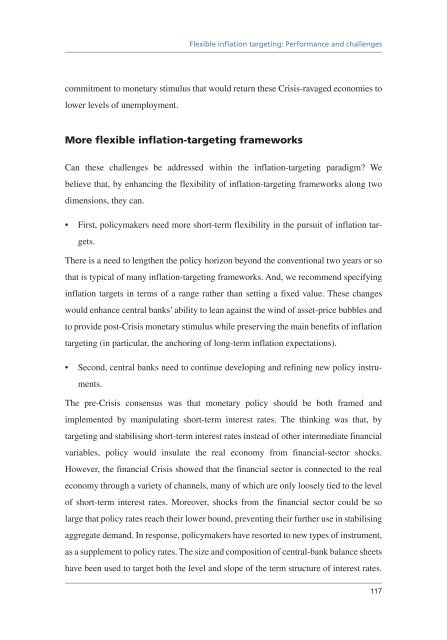You also want an ePaper? Increase the reach of your titles
YUMPU automatically turns print PDFs into web optimized ePapers that Google loves.
Flexible <strong>inflation</strong> <strong>targeting</strong>: Performance and challengescommitment to monetary stimulus that would return these Crisis-ravaged economies tolower levels of unemployment.More flexible <strong>inflation</strong>-<strong>targeting</strong> frameworksCan these challenges be addressed within the <strong>inflation</strong>-<strong>targeting</strong> paradigm? Webelieve that, by enhancing the flexibility of <strong>inflation</strong>-<strong>targeting</strong> frameworks along twodimensions, they can.• First, policymakers need more short-term flexibility in the pursuit of <strong>inflation</strong> targets.There is a need to lengthen the policy horizon beyond the conventional two years or sothat is typical of many <strong>inflation</strong>-<strong>targeting</strong> frameworks. And, we recommend specifying<strong>inflation</strong> targets in terms of a range rather than setting a fixed value. These changeswould enhance central banks’ ability to lean against the wind of asset-price bubbles andto provide post-Crisis monetary stimulus while preserving the main benefits of <strong>inflation</strong><strong>targeting</strong> (in particular, the anchoring of long-term <strong>inflation</strong> expectations).• Second, central banks need to continue developing and refining new policy instruments.The pre-Crisis consensus was that monetary policy should be both framed andimplemented by manipulating short-term interest rates. The thinking was that, by<strong>targeting</strong> and stabilising short-term interest rates instead of other intermediate financialvariables, policy would insulate the real economy from financial-sector shocks.However, the financial Crisis showed that the financial sector is connected to the realeconomy through a variety of channels, many of which are only loosely tied to the levelof short-term interest rates. Moreover, shocks from the financial sector could be solarge that policy rates reach their lower bound, preventing their further use in stabilisingaggregate demand. In response, policymakers have resorted to new types of instrument,as a supplement to policy rates. The size and composition of central-bank balance sheetshave been used to target both the level and slope of the term structure of interest rates.117



